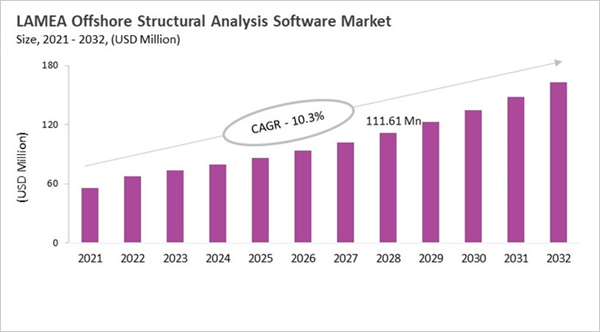The Brazil market dominated the LAMEA Offshore Structural Analysis Software Market by country in 2024, and is expected to continue to be a dominant market till 2032; thereby, achieving a market value of $43 Million by 2032. The Argentina market is showcasing a CAGR of 11.8% during 2025-2032. Additionally, the UAE market would register a CAGR of 8.1% during 2025-2032. The Brazil and Saudi Arabia led the LAMEA Offshore Structural Analysis Software Market by Country with a market share of 28.8% and 14.3% in 2024.The South Africa market is expected to witness a CAGR of 11.2% during throughout the forecast period.
Offshore structural analysis software has changed from simple finite-element and hydrodynamic tools to full-fledged, multi-physics platforms that can model complicated offshore systems like FPSOs, risers, and wind structures in very bad weather. This evolution has been made possible by improvements in simulation physics, computing power, and classification standards. These improvements have made it possible to do coupled analyses and make workflows more efficient. Digital twins, API integration, and cloud-based collaboration are some of the new features that make it possible for tools like SACS, Sesam, and OrcaFlex to do end-to-end structural assessments from design to life extension. In places like LAMEA, deepwater projects, local laws, and more offshore wind activity are driving adoption. This means that vendors need to offer localized support and lifecycle services.
Price isn't the only thing that matters in market competition. Technical breadth, integration capabilities, and lifecycle support are also important. Vendors set themselves apart by offering validated simulation modules, automation tools, and regional expertise that meets the needs of classification societies. Clients are asking for digital-twin readiness, sensor data integration, and cross-sector functionality increasingly as structural analysis becomes a part of ongoing asset integrity management. This is especially true for renewables. OEMs are using modular toolchains, cloud licensing, and service-driven business models to get more customers and reach more markets.
Structure Type Outlook
Based on Structure Type, the market is segmented into Fixed Platforms, Floating Production Systems, and Offshore Wind Foundations. The Fixed Platforms market segment dominated the UAE Offshore Structural Analysis Software Market by Structure Type is expected to grow at a CAGR of 7.4 % during the forecast period thereby continuing its dominance until 2032. Also, the Offshore Wind Foundations market is anticipated to grow as a CAGR of 8.5 % during the forecast period during 2025-2032.End-use Industry Outlook
Based on End-use Industry, the market is segmented into Oil and Gas, Offshore Wind, Marine and Naval, and Wave and Tidal Energy. Among various Brazil Offshore Structural Analysis Software Market by End-use Industry; The Oil and Gas market achieved a market size of USD $12.1 Million in 2024 and is expected to grow at a CAGR of 7.8 % during the forecast period. The Marine and Naval market is predicted to experience a CAGR of 9.3% throughout the forecast period from (2025 - 2032).Country Outlook
Brazil is a major player in offshore oil and gas production, especially in the Campos and Santos Basins, which are deepwater areas. This creates a lot of demand for structural analysis software to make sure safety and performance in tough marine conditions. The market is shaped by complex engineering needs, strict regulatory standards, and the high stakes of offshore investments. International contractors and companies like Petrobras use advanced tools for things like finite-element modeling, fatigue analysis, and multi-physics simulations. More people are interested in offshore wind and renewable energy, which is making software useful for more than just oil and gas. Some trends are using hybrid clouds, digital twins for real-time monitoring, and cloud platforms to make it easier for people to work together. There are a lot of global companies that dominate the market, like Bentley Systems, DNV, Orcina, and Siemens. Local consultancies also offer customized services. Brazil's offshore software market is going to keep growing steadily thanks to goals like expanding into deeper waters, going digital, and making operations more efficient.List of Key Companies Profiled
- Bentley Systems, Inc.
- ANSYS, Inc.
- Siemens AG
- DNV AS
- Autodesk, Inc.
- Ramboll Group A/S
- John Wood Group PLC
- Dlubal Software GmbH
- Stewart Technology Associates
- BakerRisk
Market Report Segmentation
By Deployment Model
- On-premise Licensing
- Cloud / SaaS
By Structure Type
- Fixed Platforms
- Floating Production Systems
- Offshore Wind Foundations
By Component
- Finite-Element Solvers
- Integrated Suites
- Hydrodynamic Modules
- Coupled Aero-Hydro-Servo Solvers
By End-use Industry
- Oil and Gas
- Offshore Wind
- Marine and Naval
- Wave and Tidal Energy
By Country
- Brazil
- Argentina
- UAE
- Saudi Arabia
- South Africa
- Nigeria
- Rest of LAMEA
Table of Contents
Companies Mentioned
- Bentley Systems, Inc.
- ANSYS, Inc.
- Siemens AG
- DNV AS
- Autodesk, Inc.
- Ramboll Group A/S
- John Wood Group PLC
- Dlubal Software GmbH
- Stewart Technology Associates
- BakerRisk










